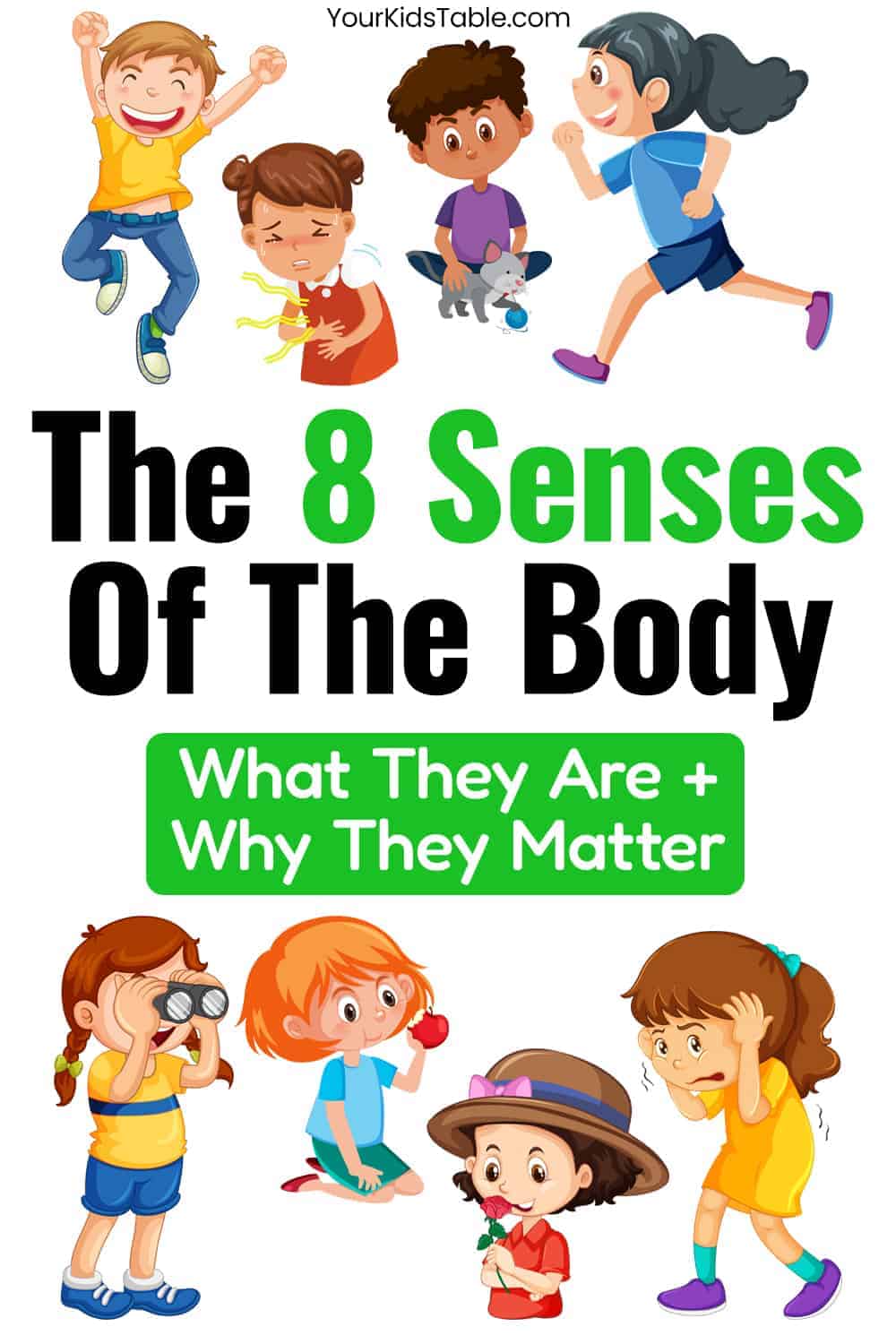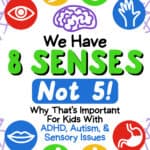Learn about the 8 senses of the body that make up sensory processing, how they work, what they each do, and how the 8 senses relate to kids with sensory processing difficulties.
Most of us know that there are 5 senses, we learned about them in kindergarten, but there are really 8 senses!
The other 3 aren’t known because they’re “hidden,” and by hidden I mean that you can’t see them, but they are constantly at work helping us to manage our bodies and do everything we need to survive.
You can think of each of the senses as its own sensory system, as each has a special part of the brain dedicated to its function.
As a pediatric occupational therapist who has worked with countless families over the years, I’ve personally witnessed how critical understanding these 8 senses are to a child’s development, behavior, and independence.
How they function is highly unique to each person and is influenced by both internal and external factors, which is why it’s so important to have a good understanding of what they are.
The 8 Senses of the Body
The 8 senses of the body make up a close-knit sensory system. What happens to one sense invariably affects the others just like a line of dominoes.
And, many of these senses are deeply interconnected, being located in similar areas of the brain or sharing the same neurological pathways.
Here are all 8 senses. First listed by the medical term, followed by the everyday language you may be more likely to hear for these senses:
- Vision (Sight)
- Auditory (Hearing)
- Gustatory (Taste)
- Olfactory (Smell)
- Proprioception (Body Position)
- Vestibular (Head position, speed, direction)
- Tactile (Touch)
- Interoception (Internal sensations)
How the 8 Senses Function
Each of these 8 senses is its own sub-system within the larger nervous system of our body. It’s composed of sensory neurons in the brain and sensory receptors throughout the body.
The receptors gather the information and send it to the part of the brain that then processes the sensation, deciding if it needs to respond and if so how.
This is known as sensory processing.
When sensory processing is running smoothly, there is a balance between the incoming information and what is being processed. When a child is calm, regulated, and focused, they are processing sensory information effectively.
But oftentimes there is an imbalance between the two, and a person becomes dysregulated, leading them to either need more input (sensory seeking) or less input (sensory sensitive).
They can even fail to register the information at all, which we refer to as low registration.
The thing is, kids can fluctuate between these states throughout the day depending on their environment and how things are being registered internally.
In fact, we all are in a constant state of sensory processing at various degrees of regulation because of the various types of sensations we experience through our 8 senses.
This process allows us to experience the sensations from our senses so we can see, hear, taste, smell, and feel the world around us and what’s happening in our own body. It also allows us to literally move through the world without falling over or bumping into things constantly.
Let’s take a look at each of the senses in more detail. We’ll start with the first 5 that everybody learns about in kindergarten and then move onto the last 3 hidden senses.
Sense #1: Vision (Sight)
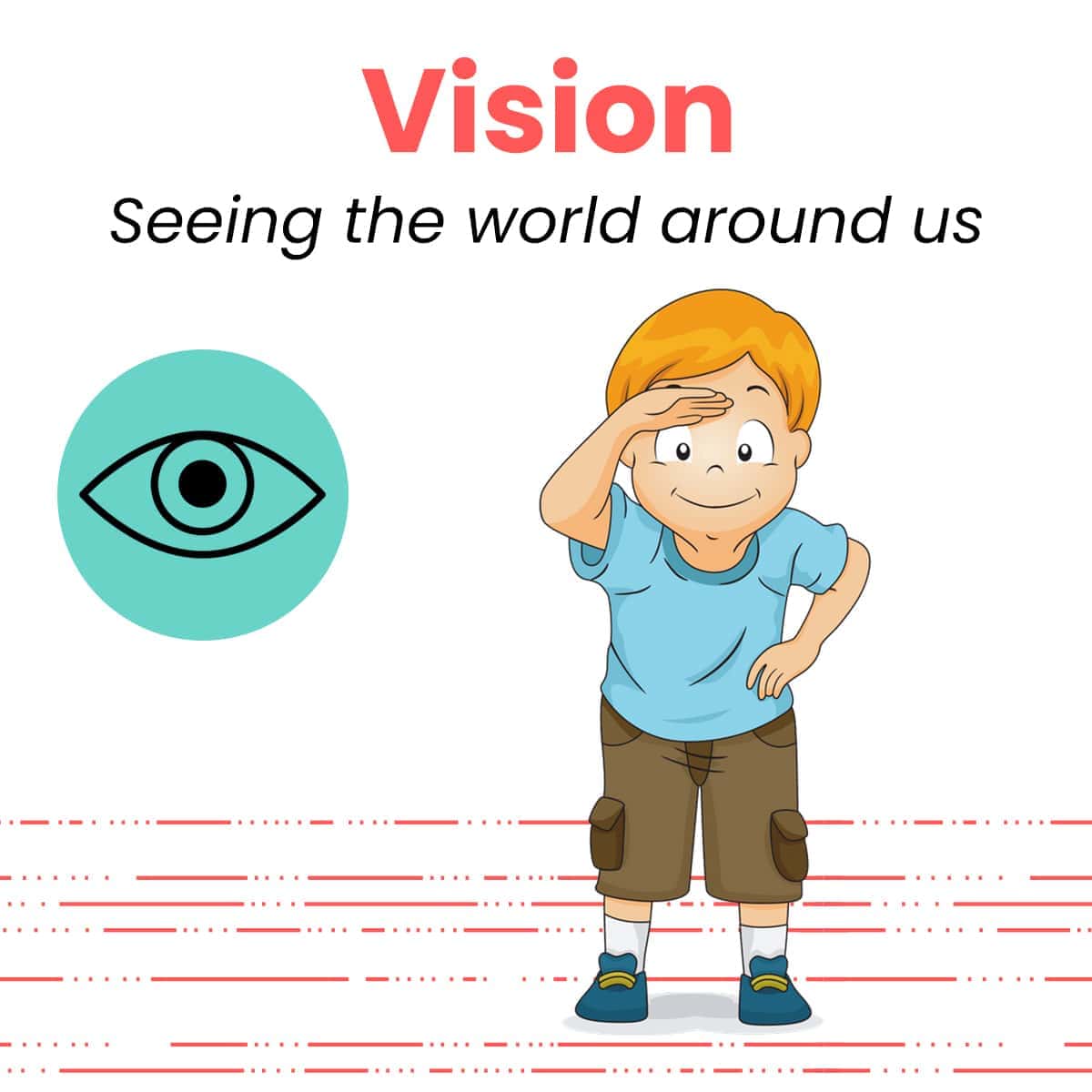
While all of our senses work together to bring us vital information about the world around us, vision is one of the most important, as it’s deeply interconnected to the other 7 senses.
In fact, the brain delegates more space to the visual system than any of the other sensory areas. There’s no doubt that vision is important!
From the moment we are born, the eyes bring light and important sensory information into the brain to begin making sense of the world.
Light, color, and shape are the “language” that the eye understands to see the world and process it.
Our sense of sight allows us to begin forming social and emotional ties to caregivers through facial recognition, directs our motor development, and eventually allows us to explore our environment through mobility.
And our visual perception, our brain’s interpretation of the visual sensory information brought in through the eyes, is important for building skills like spatial awareness, learning, and more.
For many kids, the visual sensory system can impact the rest of sensory processing because of how big of an influence it has on the other systems.
For example, a child who is sensitive to bright lights and busy stimulating environments might find certain environments overwhelming or even uncomfortable.
This can affect their ability to pay attention, be in group settings like a school cafeteria or birthday party. It can even make getting dressed difficult, because finding a specific piece of clothing in a drawer might be too distracting.
Vision can also impact a child’s willingness to try new foods, if something looks unfamiliar or even scary to them.
While being sensitive to visual input is common, children can also have a high threshold for the vision sense, and seek it out as well.
A child who is visually seeking might move their hands or bright objects repeatedly in front of their eyes, or enjoy watching things fall, break apart, or flash bright colors or lights.
But luckily, like the rest of sensory processing, things can improve. These visual sensory activities are a great way to help kids who struggle with visual processing.
Sense #2: Auditory (Hearing)
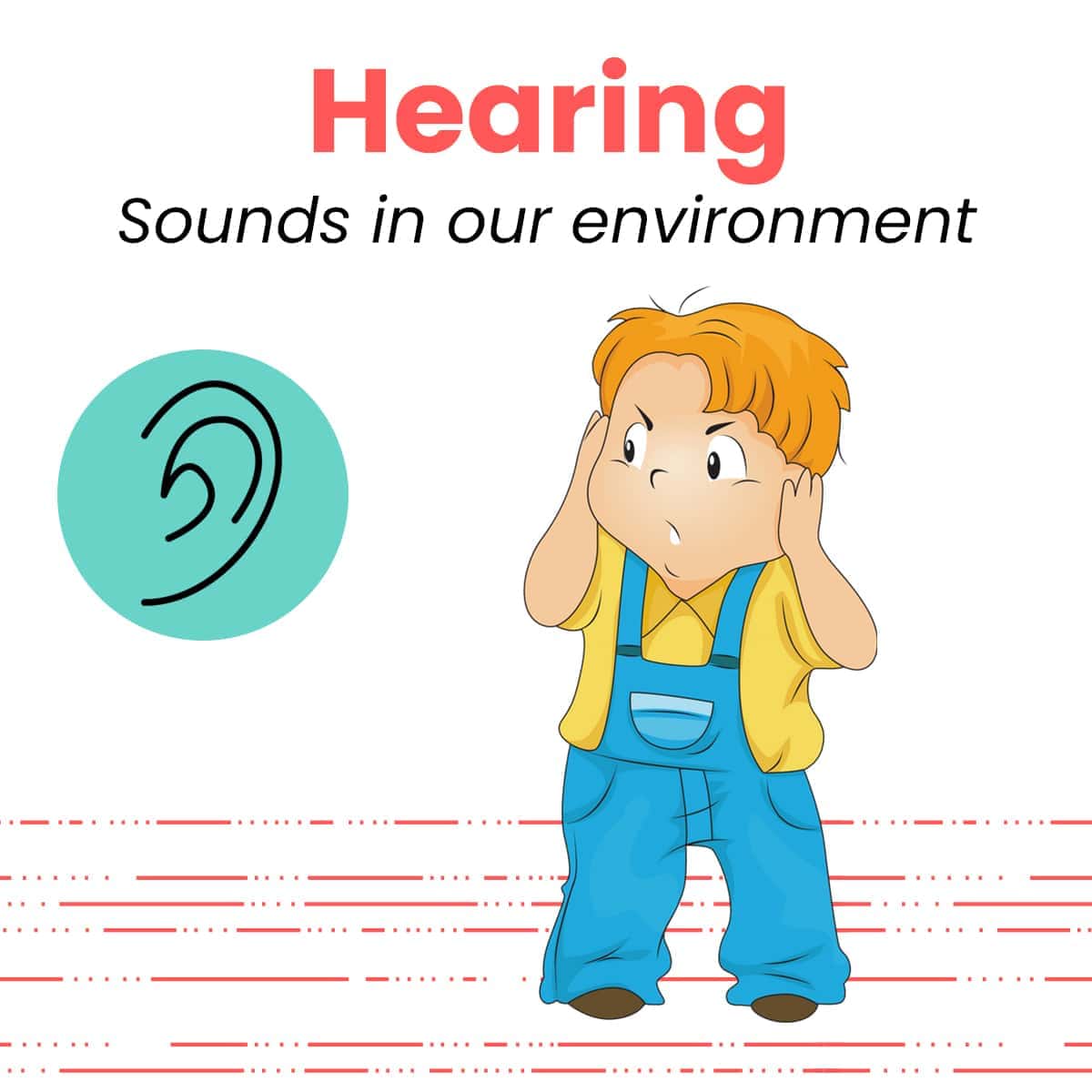
The next of our 8 senses is hearing, also known as the auditory system. Again, it’s deeply connected to other areas of sensory processing.
You’ll see a pattern here, because it is truly hard to isolate one sensory system from another.
This is why, when you see sensory difficulties in one sense, it’s important to consider if other senses are having difficulties too. The signs can be subtle.
The inner ear is responsible for our sense of hearing, which processes the sound, tone, and volume from our environment.
Our ability to hear sounds influences other areas of development like social relationships, safety awareness, and cognitive development.
If you’ve ever seen a baby calmed by his mother’s voice at birth, it’s a beautiful display of the connection that the baby has already formed from hearing his mother’s voice throughout the time he was in the womb.
He recognizes her voice because he has heard it repeatedly, and knows he is safe with his mom.
His sense of hearing will continue to improve as he grows, allowing him to build language and cognition skills, as well as to interpret his environment through hearing.
Hearing and vision go hand in hand, because when a person hears something, their eyes (and head) typically follow, leading to the development of mobility and exploration of the world.
It also is connected to balance which we will discuss later with the vestibular sense.
It’s no wonder that when a child struggles with auditory sensitivity, it can impact a lot of areas of development.
For example, a child who is sensitive to sounds might fear the automatic toilets or hand dryers of a public restroom, or may have a complete sensory meltdown when a fire truck drives by with sirens blasting.
Other kids may struggle with auditory processing, which is when sounds aren’t registered.
In this case a child might find themselves unable to follow a direction in the classroom when the chatter of other students overloads their ability to process the verbal instruction from their teacher.
On the other side of things, a child who seeks auditory input might enjoy listening to overly loud music, speak too loudly, or even scream, hum, or crave sounds that are considered unpleasant to others, like squeaking, clanging, or high pitched sounds.
Sense #3: Gustatory (Taste)
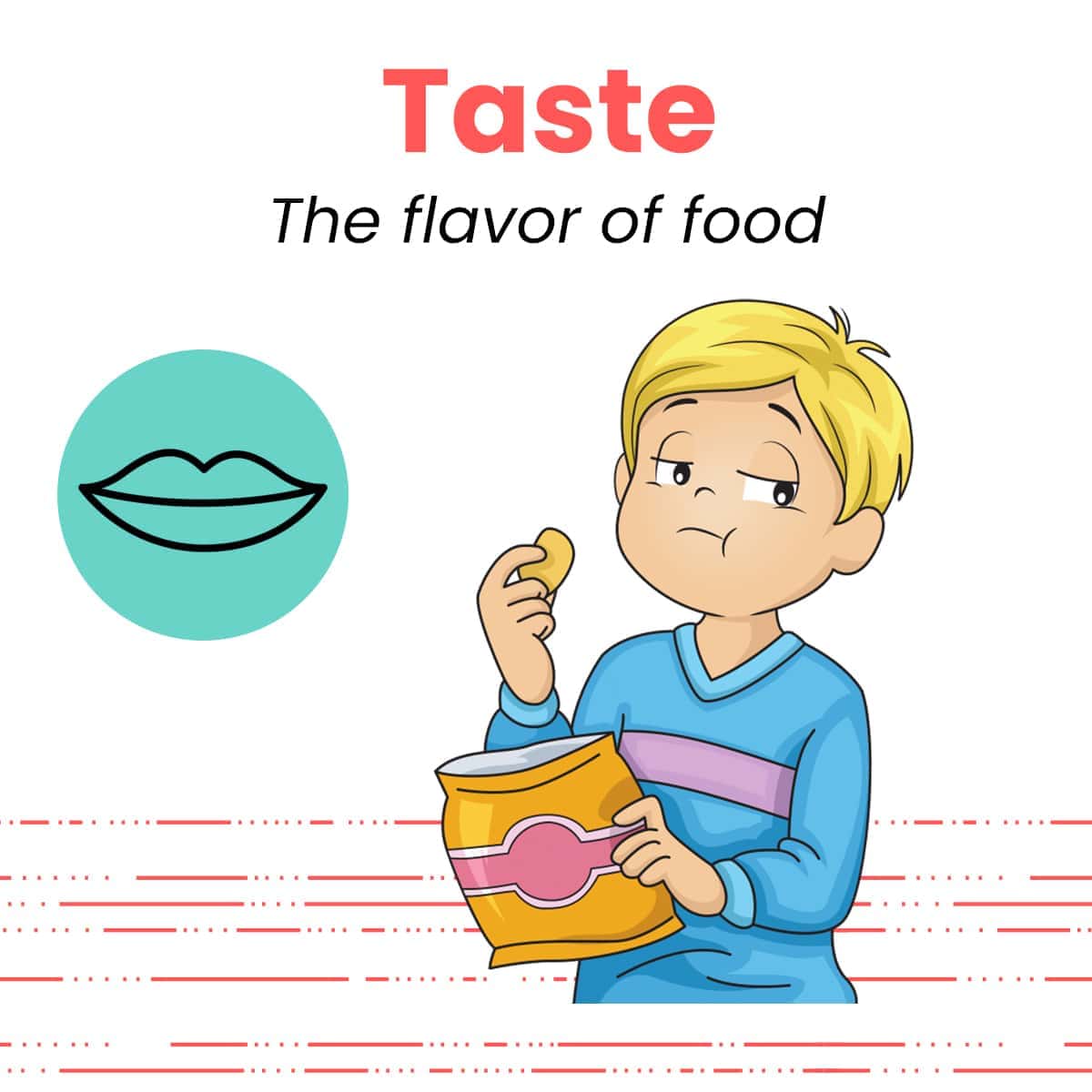
Now we’ve made it to the taste sense, which as you can imagine, has everything to do with eating.
Our sense of taste, also called the gustatory system, uses sensory receptors in our mouth to process flavor through chemical reactions that perceive sweet, salty, bitter, and sour sensations in foods.
Babies, toddlers, and young children have especially strong senses of taste, which is why they have more intense reactions to flavor than adults. This is also partially to blame for the typical period of picky eating that children in this age range go through.
Many children with sensory difficulties do not outgrow this sensitivity and continue to show aversions to strong flavors which causes them to dive further into picky eating.
However a variety of senses are involved in eating, and if a child is struggling to eat a variety of foods, it’s important to consider all the senses that play a role in oral sensory processing (tactile, taste, and proprioception).
Smell, also plays a major role in how the flavor of food is perceived. With all these senses playing a role, you can leverage sensory processing strategies to improve picky eating.
There are many other factors that play a role in picky eating though, beyond sensory. If it’s something your kid is struggling with you can read about how I turned picky eating around. And, yes he had a lot of sensory difficulties that were causing him to be so picky.
Some children seek out tastes though. Sometimes very bold flavors that are spicy, sour, or salty because they are underprocessing taste sensations. And, still other kids may describe foods as bland, showing poor registration of the flavor altogether.
Sense #4: Olfactory (Smell)
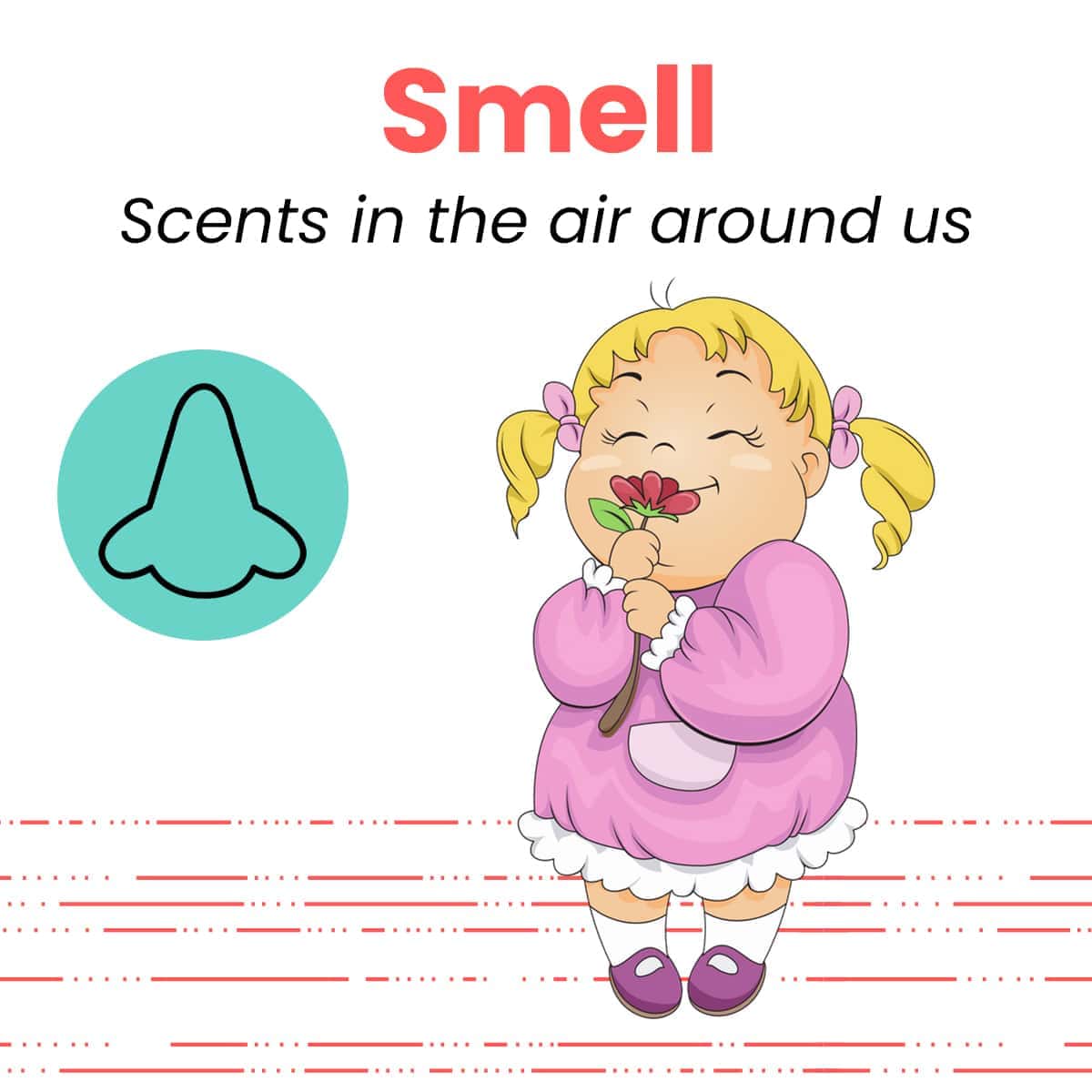
As I just mentioned, taste and our sense of smell function closely together. This means that our smell greatly impacts our ability to taste.
In fact, the two senses are together called “the chemosensory system.”
Have you ever had a cold and your stuffy nose makes it hard to taste your food? This is a great example of how these two systems work together. Try plugging your nose the next time you take a bite of food. Suddenly you can’t taste it!
Besides food, various smells are constantly around us in our environment, many of which we tend to not to notice.
But, when a child’s smell sense overprocesses the sensation they be aware of all sorts of smells the average person doesn’t notice. This can start to interfere with their daily lives. Some kids can’t stand getting a bath because of the smell of soap.
Potty training can be difficult because bathroom smells are so strong.
A child who is poorly registering smell might not notice unpleasant odors, or even seek them out, which can be dangerous if the child is interested in harmful fumes like cleaning solutions or dangerous chemicals.
And, kids can seek out smells too, which means they may like to smell strong smelling items like spices, perfumes, or permanent markers, the latter of course isn’t safe.
Sometimes smell seekers will smell everything in their environment, including people, which can become socially awkward.
If you or your child experiences any of these challenge with the smell sense, head to our post dedicated to the smell sense, which includes great smell activities too!
Sense #5: Tactile (Touch)
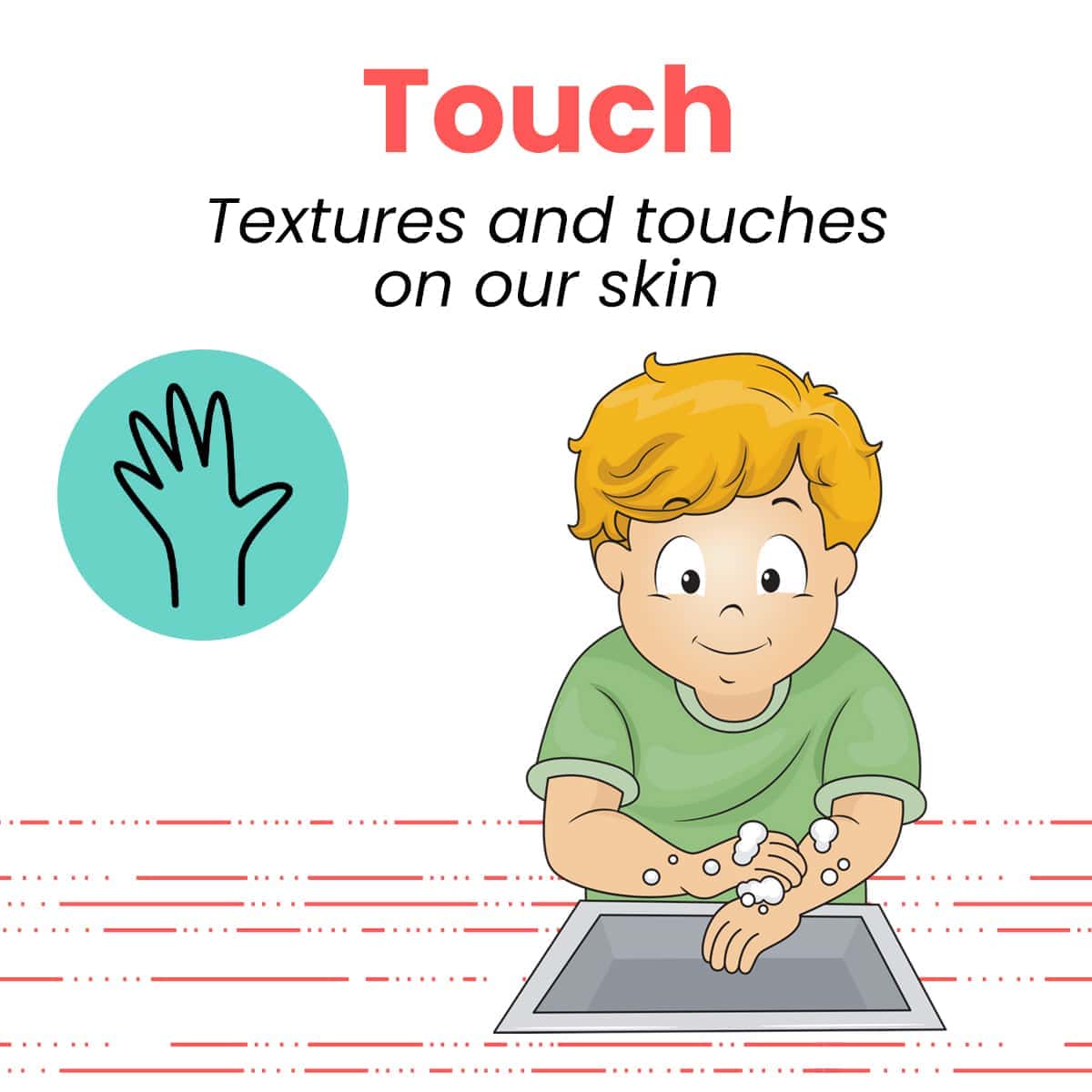
The next of the 8 senses is the tactile system, which is controlled by the body’s largest organ: the skin! This makes our sense of touch the largest sensory system of the body.
Tactile sensory receptors cover the skin, mouth, throat, digestive system, ears, and truthfully, just about everywhere in the body.
Our sense of touch is also the first sensory system to develop in the womb.
Tactile sensations create the brain’s perception of temperature, pain, vibration, and texture.
Why does this matter? Well, this impacts everything from getting dressed, to eating a variety of foods, to messy play, and independence skills like washing your hands.
When a child is sensitive to tactile input, all of these things can be difficult or even painful because the brain perceives the input as threatening. The nervous system sets off an alarm that says “warning!” and this results in a fight or flight response in some kids.
I’ve worked with tons of kids over the years who refuse certain textures on the skin because they feel downright painful. And I’ve worked with even more who gag at or avoid different textures of food.
These are both examples of tactile sensory processing difficulties.
Kids with low registration of tactile input might lack awareness of being wet, soiled, cold, or even in pain. These are common sensory signs in kids with Autism Spectrum Disorder (ASD) or those with Sensory Processing Disorder (SPD).
I want to again make it clear that while kids with these diagnoses are more likely to exhibit sensory processing difficulties, there are many kids who do not have a diagnosis, and one is certainly not needed for a child to show issues with sensory processing.
There is so much more to learn about this amazing sense check out tons of tactile activities and how to help tactile seekers and avoiders in everything you need to know about the tactile sense.
Sense #6: Proprioception (Body Position)
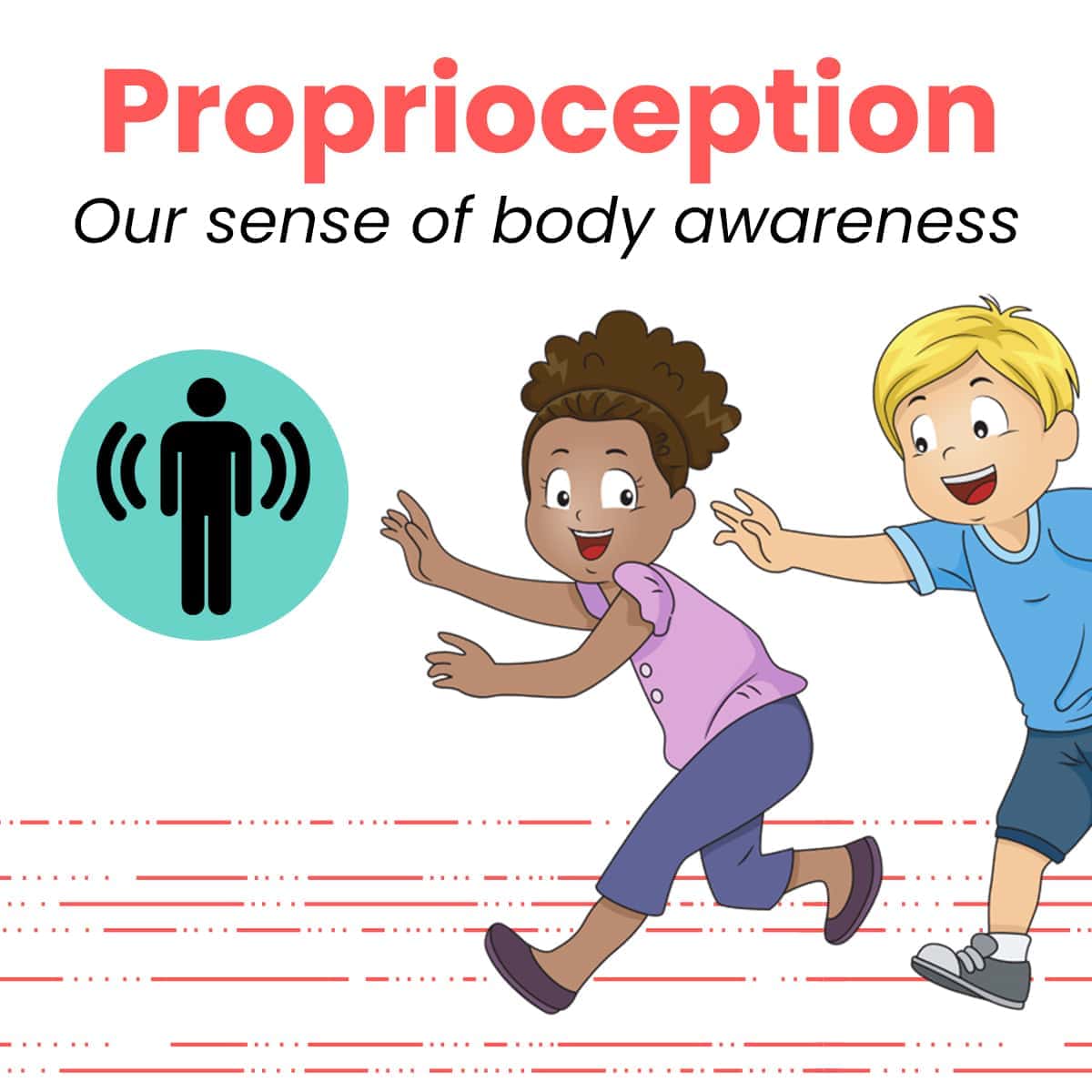
It’s hard to pick a favorite sense, but if I had to it would be proprioception, sometimes called kinesthesia.
Proprioception provides our sense of body awareness.
Inside the muscles and joints of the body are sensory receptors which give the brain feedback on the location, movement, and actions that the body is experiencing.
These sensory receptors perceive this information as position, speed, pressure, and force, which basically tells the brain “where am I?”
You can probably guess how this is important to kids’ development.
It affects everything from early milestone achievement, to fine and gross motor coordination, spatial awareness, hand-eye coordination, and safety awareness.
Children heavily rely on this sensory system to process activities like jumping, climbing, riding a bike, throwing a ball, and playing sports.
Proprioceptive input is very calming, and when kids engage in this type of movement, often referred to as “heavy work,” they can help regulate their entire sensory systems when something is off.
Things like weighted blankets, bear hugs, and joint compressions are all examples of proprioceptive input. We have a ton more proprioceptive activity ideas to check out that can really help kids who need it.
It’s extremely rare for a child to be defensive to proprioceptive input, but many proprioceptive activities also combine tactile or vestibular input, both of which are common for kids to avoid.
If your child is avoiding a proprioceptive activity it’s likely because of the other sensations it triggers.
While sensitivities are rare, low registration of proprioception is not. With low registration kids will struggle to perceive the input, they can appear clumsy, uncoordinated, or lethargic.
There are a lot of factors that go into why a child might have difficulties with their proprioceptive system (or the following sense of balance, vestibular), but retained reflexes, difficulty crossing midline, and developmental delay are reasons why a child might benefit from occupational therapy or sensory integration therapy to address these concerns.
Sense #7: Vestibular (Head position, speed, direction)
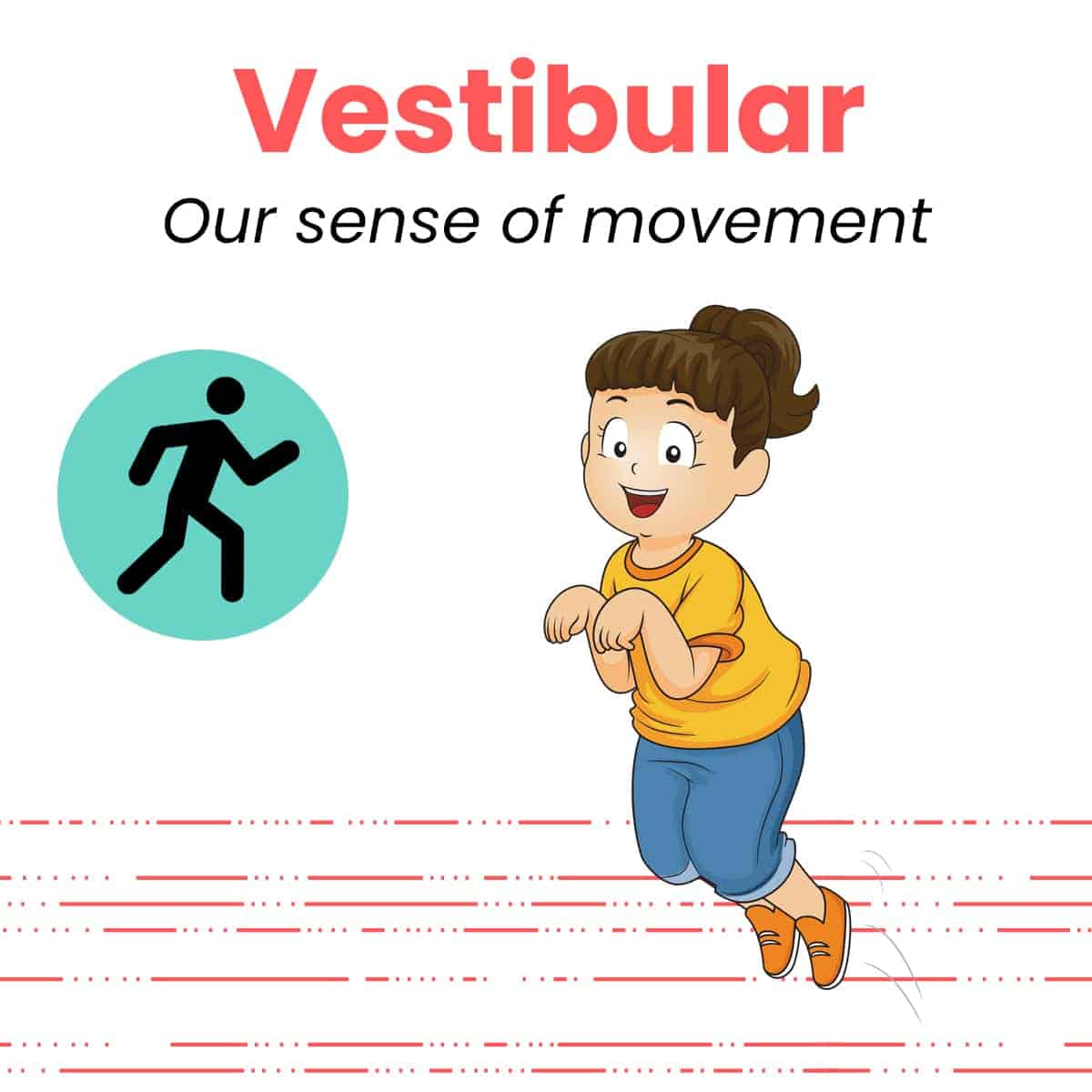
Sense number 7 is the vestibular system which is made up of sensory receptors in the inner ear.
This sensory system’s main job is to perceive and interpret the head’s position, including eye coordination, posture, balance, and speed.
As you can imagine, this also has a lot to do with coordination, and from a young age, babies use this sense to learn skills like rolling, holding their head up, and crawling.
Any time a baby turns their head to look at or hear something, vestibular processing is also at work.
As a child grows, this sense helps them process sensory input during play like swinging, spinning, balancing, knowing how fast they are moving, and in which direction.
If you’ve ever met a child who is afraid of being upside down, tipping their head back for a diaper, or is fearful of being off the ground (even just slightly) they are likely struggling with vestibular input.
The sensitivity to movement is often called gravitational insecurity.
I have met babies who hate being rocked, laid down, or bounced on a knee, and each of these was an early sign that there was something up with their vestibular sense.
On the other hand, kids who seek vestibular input might engage in high speed, fast paced activities, or seem unaffected by heights, which can be a safety risk.
See our complete guide to the vestibular sense that includes some powerful vestibular activities that are helpful for kids with gravitational insecurity or seeking it out.
Sense #8: Interoception (Internal Sensations)
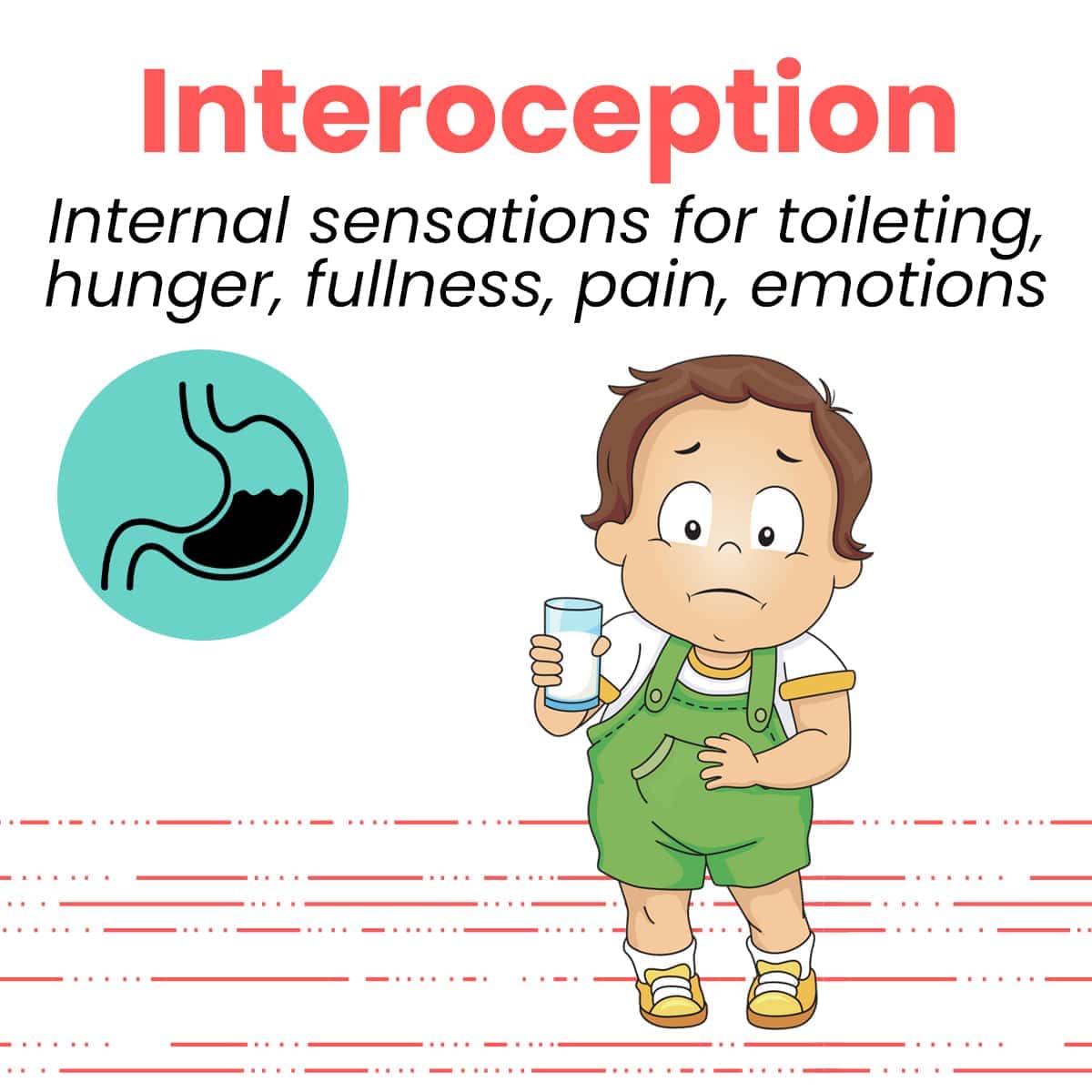
We’ve made it to sense number 8! Are you still with me?
Interoception is arguably the least universally understood sensory system. Many parents that I’ve met have never heard of it. In fact, there are occupational therapists who are still unfamiliar with it.
But despite being lesser known, this system plays a huge role in sensory processing.
There’s a reason I’m discussing it last, because it truly does tie everything together. Interoception truly is the glue between it all.
Interoception refers to our body’s perception and interpretation of internal sensations.
So feelings like “am I hot? cold? hungry? tired? Sad?” the list goes on.
It goes even deeper than that, controlling things like emotional regulation and the accompanying physical symptoms like heart rate, perspiration, and anxiety. This is the really deep stuff!
While some of these sensations are innate, like our ability to cry out from hunger the minute we are born, others take years to hone in on, and for sensory kids, sometimes this is a harder process than for someone who is neurotypical.
An interoceptive system that is balanced and functioning well allows a child to use the toilet when they should, wear appropriate clothing for the weather outside, and take a deep breath when they’re feeling angry (instead of hitting their friend.)
When a child struggles in this area, they might not be aware of any of these cues, or feel an overactive response to hunger, bowel movements, etc.
This sense can be tricky to work on, but there are definitely strategies to improve it, including practicing self regulation, mindfulness, and even following predictable routines so that kids begin to see patterns of how their body responds to different sensations.
This sensory system runs in the background of all the other 8 sensory systems, so it’s easy to overlook when a kid is struggling in another more obvious area. But it is often affected too!
How to Improve the Function of the 8 Senses of the Body
You probably noticed that sensory activities were mentioned throughout this post as a way to work on each of the senses when a child has difficulty with their sensory processing.
The reason we love activities is because you can use them as strategies, along with a sensory diet to target the exact sensory system that needs it. But it’s also highly customizable to adjust when things change- which is a common occurrence for sensory kids.
Activities are a fun way to get kids to work on building new pathways of sensory processing in the brain. Where they once recoiled in fear, touching a new texture or eating a new food, over time they can learn to accept and even enjoy those feelings.
Occupational therapists can help determine a plan to work on these things with your child, but you can also learn how to leverage these activities yourself in your own home.
A great starting point is with our free printable of 25+ sensory activities and a sensory diet template. You can snag it in our Sensory Essentials printable right here!
More on the 8 Senses
How to Explain Sensory Processing Issues to Your Child
10 Sensory Red Flags You Might Be Missing
33 Signs of Sensory Processing Disorder
Laura Mau is a licensed occupational therapist and member of the Your Kid’s Table team. She has over 8 years of clinical experience in helping families navigate complex feeding and eating, sensory processing, and reaching developmental milestones with their children. She currently practices in Colorado and has 3 young kids of her own.
Alisha Grogan is a licensed occupational therapist and founder of Your Kid’s Table. She has over 19 years experience with expertise in sensory processing and feeding development in babies, toddlers, and children. Alisha also has 3 boys of her own at home. Learn more about her here.
